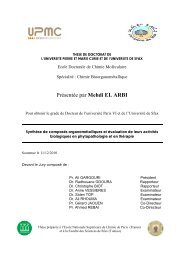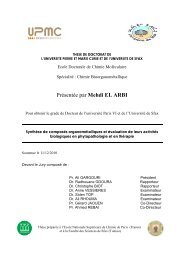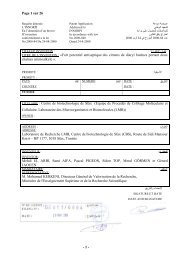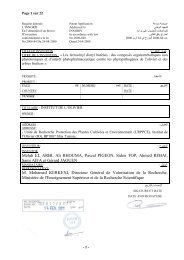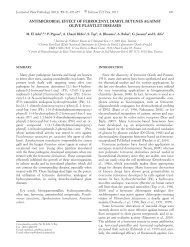A new series of ferrocifen derivatives, bearing two aminoalkyl chains
They possess the distinctive feature of combining a strong antiproliferative effect with intense antibacterial and antifungal activity
They possess the distinctive feature of combining a strong antiproliferative effect with intense antibacterial and antifungal activity
Create successful ePaper yourself
Turn your PDF publications into a flip-book with our unique Google optimized e-Paper software.
Downloaded by University College Dublin on 29 June 2011<br />
Published on 28 June 2011 on http://pubs.rsc.org | doi:10.1039/C1NJ20192A<br />
NJC<br />
Cite this: DOI: 10.1039/c1nj20192a<br />
A <strong>new</strong> <strong>series</strong> <strong>of</strong> <strong>ferrocifen</strong> <strong>derivatives</strong>, <strong>bearing</strong> <strong>two</strong> <strong>aminoalkyl</strong> <strong>chains</strong>,<br />
with strong antiproliferative effects on breast cancer cellsw<br />
Pascal Pigeon, a Siden Top,* a Anne Vessie` res, a Michel Huche´, a Meral Görmen, a<br />
Mehdi El Arbi, a Marie-Aude Plamont, a Michael J. McGlinchey b and<br />
Ge´rard Jaouen* a<br />
Received (in Montpellier, France) 1st March 2011, Accepted 12th May 2011<br />
DOI: 10.1039/c1nj20192a<br />
We have prepared several organometallic systems whose structures are closely analogous to that<br />
<strong>of</strong> tamoxifen, the drug used in the treatment <strong>of</strong> hormone-dependent breast cancers, but which<br />
now possess <strong>two</strong> basic <strong>aminoalkyl</strong> <strong>chains</strong>: O(CH2)3NMe2. Despite the absence <strong>of</strong> a phenolic<br />
functionality, these ferrocenyl compounds 3, 4 and their organic analogue 5 recognize the<br />
estrogen receptor but in addition exhibit strong antiproliferative effects on hormone-dependent<br />
breast cancer cells (MCF-7), and also on hormone-independent ones (MDA-MB-231) with, in this<br />
case, an IC 50 value <strong>of</strong> about 0.4 mM. The ferrocenyl moiety does not create a major effect here<br />
compared to a purely organic aromatic group. On the other hand, the presence within the<br />
molecule <strong>of</strong> <strong>two</strong> vicinal basic entities, potentially allowing complexation to metal ions such as<br />
Zn 2+ , could perhaps be the key to the antiproliferative effectiveness <strong>of</strong> this <strong>series</strong> which operates<br />
via a different mechanism to that <strong>of</strong> hydroxytamoxifen 1 and hydroxy<strong>ferrocifen</strong> 2. The behaviour<br />
<strong>of</strong> these <strong>new</strong> species is discussed. They possess the distinctive feature <strong>of</strong> combining a strong<br />
antiproliferative effect with intense antibacterial and antifungal activity.<br />
Introduction<br />
The unusual reactivity <strong>of</strong> bioorganometallic species (complexes<br />
<strong>of</strong> biological interest incorporating a direct metal–carbon<br />
bond) is fuelling the emergence <strong>of</strong> a <strong>new</strong> organometallic-based<br />
approach to medicinal chemistry. 1–5 We have recently illustrated<br />
the potential <strong>of</strong> such a topic by changing the tamoxifen <strong>series</strong><br />
for <strong>ferrocifen</strong>s. 6–9 OH–Tam 1, via its pro-drug tamoxifen, is<br />
the medication most widely used to cure hormone-dependent<br />
breast cancers (Chart 1). 10–14 The main mechanism <strong>of</strong> action<br />
<strong>of</strong> this molecule is an antiestrogenic effect which occurs at low<br />
concentration (in the sub-micromolar range) via a specific<br />
interaction with the alpha form <strong>of</strong> the estrogen receptor (ERa).<br />
However non-genomic interactions, i.e. an effect not mediated<br />
by ER, have also been described, 15 but in this case the IC50<br />
value found for OH–Tam on an ER-negative cell line such as<br />
MDA-MB-231 is high (29 mM) and not useful for therapeutic<br />
purposes. 16 We have prepared a <strong>series</strong> <strong>of</strong> ferrocenyl analogues<br />
<strong>of</strong> OH–Tam by substituting the phenyl ring <strong>of</strong> OH–Tam, and<br />
a Ecole Nationale Supe´rieure de Chimie de Paris (Chimie ParisTech),<br />
Laboratoire Charles Friedel UMR CNRS 7223,<br />
11 rue Pierre et Marie Curie, 75231 Paris Cedex 05, France.<br />
E-mail: siden-top@chimie-paristech.fr,<br />
gerard-jaouen@chimie-paristech.fr;<br />
Tel: +33 1 43 26 95 55, +33 1 44 27 66 99<br />
b School <strong>of</strong> Chemistry and Chemical Biology, University College<br />
Dublin, Belfield, Dublin 4, Ireland<br />
w Dedicated to Pr<strong>of</strong>. Didier Astruc on the occasion <strong>of</strong> his 65th birthday.<br />
Dynamic Article Links<br />
View Online<br />
www.rsc.org/njc PAPER<br />
also varying the length <strong>of</strong> the amino side chain (n = 2, 3–5, 8),<br />
and found that the ferrocenyl derivative 2, with n =3,is<br />
highly cytotoxic to both hormone-dependent and hormoneindependent<br />
breast cancer cells (IC50 values in the range <strong>of</strong><br />
0.5 mM), while ferrocene itself has an IC 50 <strong>of</strong> 160 mM. 17–19 It<br />
has been hypothesized that the novel mechanism <strong>of</strong> action <strong>of</strong><br />
this Fc–OH–Tam 2 complex could involve the generation <strong>of</strong><br />
quinone methide owing to a conjugated redox ferrocenyl<br />
antenna. 20–22 Very recently we have fully characterized these<br />
quinone species and shown that they could be key metabolites<br />
explaining the different behavior between the organic and<br />
organometallic <strong>series</strong>. 23 In cancer therapy the discovery <strong>of</strong> a<br />
<strong>new</strong> type <strong>of</strong> mechanism is generally <strong>of</strong> interest. 24<br />
Access to quinone methides requires the presence <strong>of</strong> a<br />
phenolic group in the original structure. 20 However, it is also<br />
possible to generate these antiproliferative species when the<br />
phenol is replaced by an aniline since quinone imines are<br />
accessible via the same redox process triggered by the ferrocenyl<br />
antenna. 25,26 This poses the question as to the unequivocal<br />
character <strong>of</strong> such a mechanism. What happens if one blocks<br />
the generation <strong>of</strong> quinone methides by protecting the phenolic<br />
functionality <strong>of</strong> Fc–OH–Tam, by incorporating a second<br />
–O(CH2)3N(CH3)2 <strong>aminoalkyl</strong> chain identical to the one<br />
already present? This is the question we wished to examine.<br />
The first product tested in this <strong>new</strong> <strong>series</strong> was, for chronological<br />
reasons, the organometallic complex 3. 7 However,<br />
when we found that the ferrocenophanes are <strong>of</strong>ten more active<br />
This journal is c The Royal Society <strong>of</strong> Chemistry and the Centre National de la Recherche Scientifique 2011 New J. Chem.
Downloaded by University College Dublin on 29 June 2011<br />
Published on 28 June 2011 on http://pubs.rsc.org | doi:10.1039/C1NJ20192A<br />
than their open chain counterparts, 27,28 we included the cyclic<br />
compound 4. Finally, since the ferrocene in these structures<br />
can only operate conjugatively with difficulty to activate the<br />
redox activation process seen in Fc–OH–Tam, 2, we chose to<br />
add the purely organic molecule 5, where the aryl group is<br />
lipophilic but less bulky than the ferrocenyl entity. It is the<br />
totality <strong>of</strong> our results in this domain, leading to unexpected<br />
biological effects, that we present herein.<br />
Results and discussion<br />
Synthesis <strong>of</strong> the compounds<br />
The compounds 3, 4 and 5 were obtained by dialkylation <strong>of</strong><br />
the corresponding phenols 6, 7 and 8, respectively, with<br />
dimethylaminopropyl chloride hydrochloride (Scheme 1).<br />
The phenols themselves were prepared by the McMurry<br />
coupling procedure that we have used pr<strong>of</strong>itably in previous<br />
syntheses. 7,9,29<br />
The dialkylation <strong>of</strong> the diphenols 6 and 7 was carried out in<br />
DMF using sodium hydride as the base to form the diphenolate<br />
which, when heated at 90 1C with dimethylaminopropyl<br />
chloride hydrochloride, furnished 3 (20%), starting from 6,<br />
Chart 1<br />
and 4 (53%) from 7. Dialkylation <strong>of</strong> the diphenol 8 was<br />
carried out in acetone at reflux using K 2CO 3 as the base; the<br />
isolated yield <strong>of</strong> 5 was 64%.<br />
Biochemical studies<br />
The study <strong>of</strong> the effect <strong>of</strong> the three bis-dimethyl<strong>aminoalkyl</strong><br />
compounds 3, 4, 5 on the growth <strong>of</strong> hormone-independent<br />
(MDA-MB-231) and -dependent (MCF-7) breast cancer cells<br />
was performed together with the determination <strong>of</strong> their relative<br />
binding affinity (RBA) for ERa and <strong>of</strong> their lipophilicity.<br />
Results are reported in Table 1 and Fig. 1.<br />
Study <strong>of</strong> the antiproliferative effect <strong>of</strong> 3, 4 and 5 on<br />
MDA-MB-231 cells. The compounds show a strong antiproliferative<br />
effect on MDA-MB-231 which can be attributed to<br />
their cytotoxicity. Quite surprisingly these IC50 values are in the<br />
same range, around 0.40 mM, for the three compounds. This is<br />
absolutely not the case for their corresponding dimethylamino/<br />
phenol molecules, respectively, 1, 2 (Chart 1) and 9 (Chart 2)<br />
which have IC50 on MDA-MB-231 <strong>of</strong> 29, 0.5 and 0.015 mM. 16,18,31<br />
For the organic compound 5, replacement <strong>of</strong> the OH <strong>of</strong> 1 by a<br />
dimethylamino chain increases dramatically the cytotoxicity <strong>of</strong><br />
the compound (ratio = 85), it has almost no effect on the<br />
Scheme 1 Synthesis <strong>of</strong> the bis-dimethyl<strong>aminoalkyl</strong> compounds 3, 4 and 5.<br />
Table 1 Biochemical data <strong>of</strong> the compounds: IC50 values on hormone-independent breast cancer cells MDA-MB-231, relative binding affinity<br />
values (RBA) for ERa, enthalpy variation (DE) <strong>of</strong> the association <strong>of</strong> the molecules in the ERa binding site and lipophilicity (log Po/w)<br />
Compound IC50 (mM) MDA-MB-231 a<br />
RBA (%) on ERa b<br />
DE (kcal mol 1 )onERa log Po/w d<br />
View Online<br />
1 29 38.5 c<br />
151.2 3.2 (Z), 3.4 (E)<br />
3 0.45 0 2.8 0.1 89.5 3.56<br />
4 0.40 0.02 2.05 0.08 92.5 —<br />
5 0.34 0.05 54 12 136.3 3.86<br />
a After 5 days <strong>of</strong> culture. b Mean <strong>of</strong> <strong>two</strong> experiments performed on purified ERa, except for 1 (lamb uterus cytosol); the RBA value <strong>of</strong> estradiol,<br />
the compound <strong>of</strong> reference, is by definition equal to 100%. c RBA, value from ref. 9. d Measured as described in ref. 30.<br />
New J. Chem. This journal is c The Royal Society <strong>of</strong> Chemistry and the Centre National de la Recherche Scientifique 2011
Downloaded by University College Dublin on 29 June 2011<br />
Published on 28 June 2011 on http://pubs.rsc.org | doi:10.1039/C1NJ20192A<br />
Fig. 1 Effect <strong>of</strong> various concentrations <strong>of</strong> the compounds on the<br />
growth <strong>of</strong> hormone dependent breast cancer cells MCF-7 after<br />
72 hours in a medium without phenol red. Representative data <strong>of</strong> one<br />
experiment performed 3 times with similar results (six measurements<br />
limits <strong>of</strong> confidence).<br />
3/Fc–OH–Tam couple (ratio = 1.1), and it noticeably<br />
decreases in the ferrocenophane <strong>series</strong> (ratio = 0.04).<br />
Determination <strong>of</strong> the RBA values <strong>of</strong> the compounds for the alpha<br />
form <strong>of</strong> the estrogen receptor (ERa) and study <strong>of</strong> their effect on the<br />
growth <strong>of</strong> MCF-7 cells. All three molecules are recognized by the<br />
alpha form <strong>of</strong> the ER. This is a rather surprising result for these<br />
molecules lacking an OH group that is supposed to be one <strong>of</strong> the<br />
essential functional groups allowing the proper anchoring <strong>of</strong> a<br />
molecule in the ER binding site (Table 1). The high RBA value<br />
found for 5 was quite unpredictable and the decrease between 5<br />
and 3 and 4 can be attributed to the bulkiness <strong>of</strong> the ferrocenyl<br />
unit. However, the molecular modeling studies (vide infra)<br />
provide an explanation for this result.<br />
On MCF-7 cells, the three compounds show a slight, but<br />
reproducible, proliferative estrogenic effect at low concentrations<br />
(1 10 8 and 1 10 7 M; Fig. 1) after 72 h <strong>of</strong> incubation. In<br />
accordance to what is observed on MDA-MB-231 cells, they<br />
become highly cytotoxic at higher concentrations (between<br />
1 10 7 M and 1 10 6 M). We have previously noted this<br />
consecutive dual effect for other <strong>series</strong> <strong>of</strong> related complexes<br />
albeit possessing diphenolic functions. 28<br />
Molecular modeling<br />
Having seen that the three molecules 3, 4, 5 are recognized by<br />
ERa, we decided to use molecular modeling to establish the<br />
Chart 2<br />
View Online<br />
details <strong>of</strong> the molecule–receptor interaction. The structure<br />
used was that <strong>of</strong> the ligand binding domain (LBD) <strong>of</strong> ERa<br />
occupied by OH–Tam. 32 Only the amino acids that make<br />
up the wall <strong>of</strong> the cavity were retained. OH–Tam was<br />
then removed and replaced successively with 3, 4 or 5. An<br />
energy minimisation was then carried out, with the heavy<br />
atoms <strong>of</strong> the receptor immobilized, in order to establish<br />
the optimal position for the molecule within the active site.<br />
The Merck Molecular Force Field (MMFF) was employed<br />
for this purpose. Owing to the large number <strong>of</strong> atoms, in<br />
excess <strong>of</strong> the s<strong>of</strong>tware limit <strong>of</strong> 600 for quantum mechanical<br />
computations, the calculations were carried out using molecular<br />
mechanics rather than quantum mechanics. Energy variation<br />
values DE corresponding to the binding <strong>of</strong> the molecules<br />
within the active site <strong>of</strong> the receptor are shown in Table 1. It<br />
is interesting to note that these energy values are all very<br />
negative, indicating that binding <strong>of</strong> these molecules in the<br />
active site is possible. The value obtained for the organic<br />
compound 5 is very close to that <strong>of</strong> OH–Tam, although<br />
less for compounds 3 and 4, and is easily explained by the<br />
steric crowding <strong>of</strong> the ferrocenyl group. We note also that<br />
there is good correlation between these values and the RBA<br />
values.<br />
A visualization <strong>of</strong> the docking <strong>of</strong> 5 and <strong>of</strong> OH–Tam in the<br />
binding site <strong>of</strong> the estrogen receptor, in the antiestrogen<br />
conformation that corresponds to the interaction with<br />
OH–Tam, is shown in Fig. 2. This shows clearly that 5 and<br />
OH–Tam dock in a similar way inside the active site. The first<br />
anchor point <strong>of</strong> the ligand is an interaction between the<br />
nitrogen <strong>of</strong> the dimethylamino chain and the aspartic acid<br />
Asp 351. This is a strong hydrogen bond between the acid<br />
function and the terminal nitrogen <strong>of</strong> the chain, which, thanks<br />
Fig. 2 Docking <strong>of</strong> 5 (left) and OH–Tam (right) in the antagonist<br />
binding site <strong>of</strong> the a form <strong>of</strong> the human estrogen receptor (h-ERa).<br />
This journal is c The Royal Society <strong>of</strong> Chemistry and the Centre National de la Recherche Scientifique 2011 New J. Chem.
Downloaded by University College Dublin on 29 June 2011<br />
Published on 28 June 2011 on http://pubs.rsc.org | doi:10.1039/C1NJ20192A<br />
to the difference in their pKa, exist in the form <strong>of</strong> zwitterions,<br />
as shown in the following equation:<br />
In the case <strong>of</strong> OH–Tam the second anchor point is composed<br />
<strong>of</strong> <strong>two</strong> hydrogen bonds with Arg 394 and Glu 353 which,<br />
owing to their proximity, are also found as zwitterions. The<br />
first is a bond between the hydrogen atom <strong>of</strong> the phenol group<br />
and Glu 353 (in carboxylate form) and the second is a bond<br />
between the oxygen <strong>of</strong> the phenol group and Arg 394 (in the<br />
form <strong>of</strong> argininium) cf. below. Note that in Shiau’s structure, a<br />
molecule <strong>of</strong> water is also present at this level. 32<br />
In the case <strong>of</strong> 3, 4,or5, the phenol function no longer exists,<br />
which eliminates the first hydrogen bond, but the second can<br />
continue to exist, between the oxygen <strong>of</strong> the ether function <strong>of</strong><br />
the amino chain and the argininium. Owing to a displacement<br />
<strong>of</strong> the molecule within the active site, this is however less<br />
strong than with OH–Tam. Nevertheless, the whole structure<br />
is stabilized by the positioning <strong>of</strong> the aliphatic chain –(CH 2) 3–<br />
in a hydrophobic channel situated in this area. Overall,<br />
the replacement <strong>of</strong> the phenol function by the chain costs<br />
around 15 kcal mol 1 to the DE <strong>of</strong> the bond, but does not rule<br />
it out. These calculations provide a molecular basis for<br />
explaining both the RBA values <strong>of</strong> these compounds and<br />
their estrogenic effect as observed on hormone-dependent<br />
MCF-7 cells.<br />
Discussion<br />
We prepared a number <strong>of</strong> compounds selected from the<br />
<strong>ferrocifen</strong> and tamoxifen <strong>series</strong>, <strong>bearing</strong> <strong>two</strong> <strong>aminoalkyl</strong> <strong>chains</strong><br />
<strong>of</strong> the type O–(CH2)3N(CH3)2, and found that they showed a<br />
strong antiproliferative effect, probably linked to their cytoxicity,<br />
on both hormone-dependent and hormone-independent breast<br />
cancer cells. In this <strong>series</strong> the ferrocenyl unit does not seem<br />
to play a specific redox activating role but rather behaves as<br />
a compact aromatic unit similar to a lipophilic aryl group.<br />
Even though a ferrocene is a compact, lipophilic aromatic<br />
metallocene (see the log P o/w values <strong>of</strong> the compounds in<br />
Table 1), it is bulkier than a simple organic aromatic. This<br />
concept <strong>of</strong> bioisosterism has recently come to the fore to<br />
explain in part the behaviour <strong>of</strong> ferrocenyl groups in biology. 33<br />
In addition, we found recently that 3 and 5 show the same<br />
significant bactericidal and fungicidal effects (on P. aeruginosa,<br />
S. aureus and C. albicans). 34 Therefore, the driving force <strong>of</strong> the<br />
toxicity <strong>of</strong> these molecules on cancer cells, bacteria and fungi<br />
seems to be connected exclusively to the presence <strong>of</strong> <strong>two</strong><br />
<strong>aminoalkyl</strong> <strong>chains</strong>. This result differs from that reported for<br />
the ferrocenyl-diamine 10. In that case the ferrocenyl complex<br />
is active against the bacterium Mycobacterium tuberculosis<br />
while its organic equivalent, 11, is 8 times less effective. 35<br />
The toxicity <strong>of</strong> these compounds seems closer to that found<br />
for polyamines derived from putrescine and spermine than to<br />
that <strong>of</strong> our compounds. 36 We note also that cobaltifen 12<br />
(Chart 2) has been described and an IC 50 value <strong>of</strong> 2.5 mM was<br />
found on this same cell line, MDA-MB-231. 37 This value,<br />
more than six times higher than that <strong>of</strong> the compounds<br />
described here, can be explained by the presence <strong>of</strong> a very<br />
bulky organometallic group which dilutes the relative<br />
influence <strong>of</strong> the <strong>aminoalkyl</strong> <strong>chains</strong>.<br />
Finally, Japanese researchers have synthesized and studied<br />
ridaifen-B 13 (Chart 2). 38,39 This compound shows a potent<br />
antiproliferative effect on both MDA-MB-231 and MCF-7<br />
cells (IC 50 value <strong>of</strong> 1.3 mM after 48 h). In addition a<br />
COMPARE analysis performed on different cell lines<br />
revealed that the mechanism <strong>of</strong> action <strong>of</strong> this molecule<br />
differs from that <strong>of</strong> tamoxifen. They also showed that the<br />
toxicity <strong>of</strong> other symmetrical diamines was very similar. 38 This<br />
leads us to consider the origin <strong>of</strong> the significant toxicity<br />
demonstrated by this family <strong>of</strong> molecules.<br />
Since molecules 3, 4, 5 and 12 can be excellent complexing<br />
agents, we used molecular modelling to estimate their affinities<br />
with Zn 2+ , starting from the idea that this metal is strongly<br />
present in the cells and that its displacement, thanks to the<br />
presence <strong>of</strong> basic pincer groups, could lead to their malfunction.<br />
AZn 2+ cation was placed between the <strong>two</strong> amino <strong>chains</strong> <strong>of</strong> 3,<br />
4, and 5, and an energy minimisation was then carried out by<br />
the use <strong>of</strong> the Merck Molecular Force Field (MMFF) followed<br />
by semi-empirical quantum mechanical calculations (PM3).<br />
The DrH1 enthalpy <strong>of</strong> formation <strong>of</strong> the resulting complex was<br />
obtained, and then in each case, the complex was dissociated<br />
without geometric modification into <strong>two</strong> entities: a Zn 2+ cation<br />
and a molecule <strong>of</strong> 3, 4 or 5. The variations in DrH1 enthalpy <strong>of</strong><br />
the complexation were calculated from the equation:<br />
DrH1 = DrH1(complex) DrH1(molecule) DrH1(Zn 2+ ).<br />
A D rH1 value around 275 kcal mol 1 was obtained for all<br />
these compounds. This result confirms that these molecules<br />
are likely to be good complexing agents for divalent cations<br />
such as Zn 2+ as well as Ca 2+ . This hypothesis seems to<br />
be verified by the formation <strong>of</strong> a complex between 3 and<br />
ZnCl2. In fact, addition <strong>of</strong> one equivalent <strong>of</strong> ZnCl2 dissolved<br />
in THF to a THF solution <strong>of</strong> 3 led immediately to the<br />
formation <strong>of</strong> an orange oil at the bottom <strong>of</strong> the flask. Addition<br />
<strong>of</strong> water to this orange oil produced a yellow solution proving<br />
that the complex is partially soluble in water. The 1 H NMR<br />
spectrum <strong>of</strong> the complex in DMSO-d6 shows a slight deshielding<br />
<strong>of</strong> the protons <strong>of</strong> the CH 2CH 2NMe 2 group (1.83–1.98,<br />
2.46 and 2.48, 2.23 and 2.24 ppm, respectively) compared to<br />
that <strong>of</strong> 3 (1.78–1.94, 2.36 and 2.38, 2.16 and 2.17 ppm,<br />
respectively); the remaining protons are unchanged. Other<br />
complexing agents for dicationic metals such as hydroxamic<br />
acid, present at the end <strong>of</strong> the SAHA chain, have also been<br />
identified. 40–42<br />
Conclusion<br />
View Online<br />
We have shown that in the <strong>series</strong> <strong>of</strong> the OH–<strong>ferrocifen</strong>s, where<br />
the formation <strong>of</strong> quinone methides can give rise to a strong<br />
cytotoxic effect on cancer cells, there may be another possibility<br />
New J. Chem. This journal is c The Royal Society <strong>of</strong> Chemistry and the Centre National de la Recherche Scientifique 2011
Downloaded by University College Dublin on 29 June 2011<br />
Published on 28 June 2011 on http://pubs.rsc.org | doi:10.1039/C1NJ20192A<br />
<strong>of</strong> action if the phenol function is blocked by an <strong>aminoalkyl</strong><br />
chain that prevents the generation <strong>of</strong> quinone methides. This<br />
possibility is not specific to organometallic species since it is<br />
conserved when the metallocene is replaced by an organic<br />
arene. This means <strong>of</strong> access to <strong>new</strong> cytotoxic compounds will<br />
require <strong>new</strong> targets to be identified. This will be the subject <strong>of</strong><br />
further study, although several possible leads have been<br />
suggested here, such as the complexing role <strong>of</strong> <strong>two</strong> <strong>aminoalkyl</strong><br />
<strong>chains</strong> on metallic acid cations like Zn 2+ or Ca 2+ . We note<br />
that these entities combine an antitumoral effect with an<br />
antibiotic effect. 34<br />
Experimental<br />
General remarks<br />
All reactions took place under argon using standard Schlenk<br />
techniques. Anhydrous THF was obtained by distillation<br />
from sodium/benzophenone. Thin layer chromatography<br />
was performed on silica gel 60 GF254. Infrared spectra were<br />
obtained on an IRFT BOMEM Michelson-100 spectrometer<br />
equipped with a DTGS detector as a KBr plate. 1 H and 13 C<br />
NMR spectra were recorded on a 300 MHz Bruker spectrometer.<br />
Mass spectrometry was performed with a Nermag R<br />
10-10C spectrometer. Elemental analyses were performed by<br />
the microanalysis service <strong>of</strong> CNRS at Gif sur Yvette. HRMS<br />
measurements were performed by a Thermo Fischer LTQ-<br />
Orbitrap XL apparatus with an electrospray source.<br />
1,1-Bis[4-(3-dimethylaminopropoxy)phenyl]-2-ferrocenyl-but-1-ene, 3<br />
Compound 6 (0.424 g, 1 mmol) was dissolved in 10 mL <strong>of</strong><br />
DMF and sodium hydride (0.32 g, 8 mmol) was added. The<br />
mixture was stirred for 10 min, then 3-dimethylamino-1propyl<br />
chloride hydrochloride (0.375 g, 2.5 mmol) was added.<br />
The mixture was heated at 90 1C overnight. The mixture<br />
was cooled and 5 mL <strong>of</strong> ethanol were slowly added in order<br />
to destroy the remaining sodium hydride. Then, the mixture<br />
was concentrated under reduced pressure. The residue was<br />
dissolved in dichloromethane, washed twice with a diluted<br />
aqueous solution <strong>of</strong> sodium hydroxide followed with water.<br />
After drying on magnesium sulfate, the solution was concentrated<br />
under reduced pressure and the residue was chromatographed<br />
on silicagel with a 4/1 solution <strong>of</strong> chlor<strong>of</strong>orm/<br />
triethylamine as eluent to yield product 3 as an oil in 20%<br />
yield. An alternative route <strong>of</strong> synthesis <strong>of</strong> 3 was published<br />
recently. 34 1 H NMR (300 MHz, CDCl 3): d 0.94 (t, J = 7.4 Hz,<br />
3H, CH 3), 1.79–1.95 (m, 4H, CH 2), 2.18 (s, 6H, NMe 2), 2.19<br />
(s, 6H, NMe 2), 2.37 (t, J = 7.2 Hz, 2H, CH 2N), 2.40 (t, J =<br />
7.2 Hz, 2H, CH 2N), 2.50 (q, J = 7.4 Hz, 2H, CH 2), 3.83<br />
(t, J = 1.9 Hz, 2H, C5H4), 3.89 (t, J = 6.6 Hz, 2H, CH2O),<br />
3.91 (t, J = 6.6 Hz, 2H, CH2O), 3.98 (t, J = 1.9 Hz, 2H,<br />
C5H4), 4.02 (s, 5H, Cp), 6.66 (d, J = 8.7 Hz, 2H, C6H4), 6.77<br />
(d, J = 8.7 Hz, 2H, C6H4), 6.86 (d, J = 8.7 Hz, 2H, C6H4),<br />
7.02 (d, J = 8.7 Hz, 2H, C6H4). 13 C NMR (75 MHz, CDCl3):<br />
d 15.5 (CH3), 27.5 (CH2), 27.6 (CH2), 27.9 (CH2), 45.5<br />
(2NMe2), 56.5 (2CH2N), 66.1 (2CH2O), 67.9 (2CH C5H4),<br />
69.1 (5CH Cp), 69.3 (2CH C 5H 4), 87.2 (C C 5H 4), 114.1<br />
(2CH C 6H 4), 114.2 (2CH C 6H 4), 130.4 (2CH C 6H 4), 130.9<br />
(2CH C 6H 4), 136.5 (C), 137.2 (C), 137.3 (C), 137.4 (C),<br />
157.3 (2 C). IR (KBr, n/cm 1 ): 2948, 2868, 2816, 2764<br />
(CH2, CH3). MS (EI, 70 eV) m/z: 594 [M] + , 121 [CpFe] + ,<br />
86 [CH 2CH 2CH 2NMe 2] + , 58 [CH 2NMe 2] + . HRMS (ESI,<br />
C 36H 47FeN 2O 2: [M + H] + ) calcd: 595.29815, found:<br />
595.29681. The monoalkylated Fc–OH–TAM 2 was also<br />
isolated in 36% yield. Anal. Calcd for C 36H 46FeN 2O 2(H 2O):<br />
C, 70.54; H, 7.80; N, 4.67%. Found: C, 70.58; H, 7.90;<br />
N, 4.57%.<br />
1-[Bis(4-(3-dimethylaminopropoxy)phenyl)methylidene]-<br />
[3]ferrocenophane, 4<br />
View Online<br />
Compound 7 (0.422 g, 1 mmol) was dissolved in 10 mL <strong>of</strong><br />
DMF and sodium hydride (0.32 g, 8 mmol) was added. The<br />
mixture was stirred for 10 min, then 3-dimethylamino-<br />
1-propyl chloride hydrochloride (0.375 g, 2.5 mmol) was<br />
added. The mixture was heated at 90 1C overnight, then more<br />
3-dimethylamino-1-propyl chloride hydrochloride (0.375 g,<br />
2.5 mmol) was added. The heating was continued for 4 h.<br />
The mixture was cooled and 5 mL <strong>of</strong> ethanol were slowly<br />
added in order to destroy the remaining sodium hydride.<br />
Then, the mixture was cooled and concentrated under reduced<br />
pressure. The residue was dissolved in dichloromethane and<br />
was washed twice with a diluted aqueous solution <strong>of</strong> sodium<br />
hydroxide followed with water. After drying over magnesium<br />
sulfate, the solution was concentrated under reduced pressure<br />
and the residue was chromatographed on silicagel with a 4/1<br />
solution <strong>of</strong> chlor<strong>of</strong>orm/triethylamine as eluent. The residue<br />
was recrystallized from ethanol–water solution to yield product<br />
4 in 53% yield. Mp: 119 1C. 1 H NMR (300 MHz, CDCl3):<br />
d 1.75–1.87 (m, 2H, CH2), 1.87–2.13 (m, 2H, CH2), 2.17 (s, 6H,<br />
NMe2), 2.21 (s, 6H, NMe2), 2.24–2.31 (m, 2H, CH2 cycle),<br />
2.35 (t, J = 7.2 Hz, 2H, CH2N), 2.42 (t, J = 7.2 Hz, 2H,<br />
CH2N), 2.54–2.68 (m, 2H, CH2 cycle), 3.83 (t, J = 6.3 Hz, 2H,<br />
CH2O), 3.89 (s, 4H, C5H4), 3.94 (s, 2H, C5H4), 3.96 (t, J =<br />
6.3 Hz, 2H, CH 2O), 4.13 (s, 2H, C 5H 4), 6.53 (d, J = 8.3 Hz,<br />
2H, C 6H 4), 6.80 (d, J = 8.3 Hz, 2H, C 6H 4), 6.86 (d, J =<br />
8.3 Hz, 2H, C 6H 4), 7.05 (d, J = 8.3 Hz, 2H, C 6H 4). 13 C NMR<br />
(75 MHz, CDCl 3): d 27.5 (CH 2), 27.6 (CH 2), 28.7 (CH 2 cycle),<br />
41.1 (CH2 cycle), 45.4 (NMe2), 45.5 (NMe2), 56.4 (2CH2N),<br />
65.9 (CH2O), 66.1 (CH2O), 68.2 (2CH C5H4), 68.6 (2CH<br />
C5H4), 70.1 (2CH C5H4), 70.2 (2CH C5H4), 84.0 (C C5H4),<br />
86.8 (C C5H4), 113.1 (2CH C6H4), 114.0 (2CH C6H4),<br />
130.4 (2CH C6H4), 131.7 (2CH C6H4), 133.1 (C), 135.8 (C),<br />
136.2 (C), 140.2 (C), 157.1 (C), 157.7 (C). IR (KBr, n/cm 1 ):<br />
2943, 2856, 2814, 2763 (CH2, CH3). MS (EI, 70 eV) m/z: 592<br />
[M] + , 86 [CH 2CH 2CH 2NMe 2] + , 58 [CH 2NMe 2] + . HRMS<br />
(ESI, C 36H 45FeN 2O 2:[M+H] + ) calcd: 593.28250, found:<br />
593.28145. Anal. Calcd for C 36H 44FeN 2O 2(H 2O) 0.25: C, 72.42;<br />
H, 7.51; N, 4.69%. Found: C, 72.47; H, 7.54; N, 4.56%.<br />
1,1-Bis[4-(3-dimethylaminopropoxy)phenyl]-2-phenyl-but-1-ene, 5<br />
Compound 8 (1.58 g, 5 mmol) and potassium carbonate<br />
(2.764 g, 20 mmol) were stirred in 100 mL <strong>of</strong> acetone, then<br />
3-dimethylamino-1-propyl chloride hydrochloride (1.739 g,<br />
11 mmol) was added. The mixture was refluxed overnight,<br />
cooled and concentrated under reduced pressure. The residue<br />
was dissolved in dichloromethane then was washed twice with a<br />
diluted aqueous solution <strong>of</strong> sodium hydroxide followed with water.<br />
This journal is c The Royal Society <strong>of</strong> Chemistry and the Centre National de la Recherche Scientifique 2011 New J. Chem.
Downloaded by University College Dublin on 29 June 2011<br />
Published on 28 June 2011 on http://pubs.rsc.org | doi:10.1039/C1NJ20192A<br />
After drying over magnesium sulfate, the solution was<br />
concentrated under reduced pressure and the residue was<br />
recrystallized from ethanol–water solution to yield product 5<br />
in 64% yield. Mp: 91 1C. 1 H NMR (300 MHz, CDCl 3): d 0.84<br />
(t, J = 7.4 Hz, 3H, CH 3), 1.71–1.84 (m, 2H, CH 2), 1.84–1.98<br />
(m, 2H, CH 2), 2.13 (s, 6H, NMe 2), 2.18 (s, 6H, NMe 2), 2.30<br />
(t, J = 7.3 Hz, 2H, CH2N), 2.34–2.47 (m, 4H, CH2 +CH2N),<br />
3.78 (t, J = 6.4 Hz, 2H, CH2O), 3.94 (t, J = 6.4 Hz, 2H,<br />
CH2O), 6.45 (d, J = 8.8 Hz, 2H, C6H4), 6.67 (d, J = 8.8 Hz,<br />
2H, C6H4), 6.79 (d, J = 8.7 Hz, 2H, C6H4), 6.93–7.13 (m, 7H,<br />
C6H5 +C6H4). 13 C NMR (75 MHz, CDCl3): d 13.6 (CH3),<br />
27.5 (CH2), 27.6 (CH2), 29.0 (CH2), 45.2 (NMe2), 45.5 (NMe2),<br />
56.4 (CH2N), 56.5 (CH2N), 65.9 (CH2O), 66.1 (CH2O), 113.3<br />
(2CH C 6H 4), 114.0 (2CH C 6H 4), 125.9 (CH C 6H 5), 127.8<br />
(2CH arom), 129.7 (2CH arom), 130.6 (2CH arom), 131.9 (2CH arom),<br />
135.7 (C), 136.2 (C), 137.9 (C), 140.9 (C), 142.7 (C), 156.9 (C),<br />
157.7 (C). IR (KBr, n/cm 1 ): 2953, 2871, 2813, 2762 (CH 2,<br />
CH3). HRMS (ESI, C32H43N2O2:[M+H] + ) calcd: 487.33191,<br />
found: 487.33075. Anal. Calcd for C32H42N2O2(H2O)0.25: C,<br />
78.25; H, 8.72; N, 5.70%. Found: C, 78.26; H, 8.53; N, 5.46%.<br />
Complexation <strong>of</strong> 1,1-bis[4-(3-dimethylaminopropoxy)phenyl]-2ferrocenyl-but-1-ene,<br />
3, with ZnCl2<br />
Compound 3 (0.92 g, 1.55 mmol) was dissolved in 4 mL <strong>of</strong><br />
THF. A solution <strong>of</strong> ZnCl2 (0.21 g, 1.55 mmol) in THF (4 mL)<br />
was slowly added. An orange oil was immediately formed at<br />
the bottom <strong>of</strong> the flask. The solvent was removed to leave the<br />
Zn complex as an orange oil that was dried under vacuum.<br />
1<br />
H NMR (300 MHz, DMSO-d6) <strong>of</strong> compound 3 without<br />
addition <strong>of</strong> ZnCl2: d 1.02 (t, J = 7.2 Hz, 3H, CH3), 1.78–1.94<br />
(m, 4H, CH2), 2.16 (s, 6H, NMe2), 2.17 (s, 6H, NMe2), 2.36<br />
(t, J = 7.0 Hz, 2H, CH2N), 2.38 (t, J = 7.0 Hz, 2H, CH2N),<br />
2.49 (q, J = 7.2 Hz, 2H, CH2, partially hidden by DMSO),<br />
3.85 (s, 2H, C5H4), 3.96 (t, J = 6.2 Hz, 2H, CH2O), 4.00<br />
(t, J = 6.2 Hz, 2H, CH2O), 4.12 (s, 2H, C5H4), 4.15 (s, 5H, Cp),<br />
6.83 (d, J = 8.4 Hz, 2H, C6H4), 6.91 (d, J = 8.4 Hz, 2H, C6H4),<br />
6.93 (d, J = 8.4 Hz, 2H, C6H4), 7.12 (d, J = 8.4 Hz, 2H, C6H4).<br />
1<br />
H NMR (300 MHz, DMSO-d6) <strong>of</strong> compound 3 with<br />
addition <strong>of</strong> ZnCl2: d 1.02 (t, J = 7.2 Hz, 3H, CH3), 1.83–1.98 (m, 4H, CH2), 2.23 (s, 6H, NMe2), 2.24 (s, 6H,<br />
NMe2), 2.46 (t, J = 7.0 Hz, 2H, CH2N), 2.48 (t, J = 7.0 Hz,<br />
2H, CH2N), 2.49 (q, J = 7.2 Hz, 2H, CH2, partially hidden by<br />
DMSO), 3.85 (s, 2H, C5H4), 3.96 (t, J = 6.2 Hz, 2H, CH2O),<br />
4.00 (t, J = 6.2 Hz, 2H, CH2O), 4.12 (s, 2H, C5H4), 4.15<br />
(s, 5H, Cp), 6.83 (d, J = 8.4 Hz, 2H, C6H4), 6.91 (d, J =<br />
8.4 Hz, 2H, C6H4), 6.94 (d, J = 8.4 Hz, 2H, C6H4), 7.12<br />
(d, J = 8.4 Hz, 2H, C6H4).<br />
Biochemical experiments<br />
Materials<br />
Stock solutions (1 10 3 M) and serial dilutions <strong>of</strong> the<br />
compounds to be tested were prepared in DMSO just prior<br />
to use. Dulbecco’s Modified Eagle Medium (DMEM), fetal<br />
calf serum, glutamine and kanamycin were obtained from<br />
Invitrogen. MCF-7 and MDA-MB-231 cells were from the<br />
Human Tumor Cell Bank. Glutamine, 17b-estradiol and<br />
protamine sulfate were from Sigma.<br />
Determination <strong>of</strong> the Relative Binding Affinity (RBA) <strong>of</strong> the<br />
compounds for ERa<br />
RBA values were measured on ERa purchased from Pan Vera<br />
(Madison, WI, USA). A volume <strong>of</strong> 10 mL <strong>of</strong> the solution<br />
containing 3500 pmol mL 1 were added to 16 mL <strong>of</strong> buffer<br />
(10% glycerol, 50 mM bis-tris-propane pH 9, 400 mM KCl,<br />
2 mM DTT, 1 mM EDTA, 0.1% BSA) in a silanized flask.<br />
Aliquots (200 mL) <strong>of</strong> this solution in polypropylene tubes were<br />
incubated for 3 h at 0 1C with [6,7- 3 H]-estradiol (2 10 9 M,<br />
specific activity 1.62 TBq mmol 1 , NEN Life Science, Boston<br />
MA) in the presence <strong>of</strong> nine concentrations <strong>of</strong> the compounds<br />
to be tested. At the end <strong>of</strong> the incubation period, the free and<br />
bound fractions <strong>of</strong> the tracer were separated by protamine<br />
sulfate precipitation. The percentage reduction in binding <strong>of</strong><br />
[ 3 H]-estradiol (Y) was calculated using the logit transformation<br />
<strong>of</strong> Y (logit Y: ln[y/1 Y] versus the log <strong>of</strong> the mass <strong>of</strong> the<br />
competing steroid. The concentration <strong>of</strong> unlabeled steroid<br />
required to displace 50% <strong>of</strong> the bound [ 3 H]-estradiol was calculated<br />
for each steroid tested, and the results were expressed as<br />
RBA. The RBA value <strong>of</strong> estradiol is by definition equal to 100%.<br />
Culture conditions<br />
Cells were maintained in monolayer culture in DMEM with<br />
phenol red/Glutamax I, supplemented with 9% <strong>of</strong> decomplemented<br />
fetal calf serum and 0.9% kanamycin, at 37 1Cina5%<br />
CO2 air humidified incubator. For proliferation assays, cells<br />
were plated in 24-well sterile plates with 1.5 10 4 cells for<br />
MDA-MB-231 and with 3 10 4 cells for MCF-7 in 1 mL <strong>of</strong><br />
DMEM without phenol red, supplemented with 9% <strong>of</strong> fetal<br />
calf serum desteroided on dextran charcoal, 0.9% Glutamax I<br />
and 0.9% kanamycin, and were incubated for 24 h. The<br />
following day (D0), 1 mL <strong>of</strong> the same medium containing<br />
the compounds to be tested diluted in DMSO, was added to<br />
the plates (final volumes <strong>of</strong> DMSO: 0.1%; 4 wells for each<br />
condition). After three days (D3), the incubation medium was<br />
removed and 2 mL <strong>of</strong> fresh medium containing the compounds<br />
was added. At different days (D3, D4, D5 and D6),<br />
the protein content <strong>of</strong> each well was quantified by methylene<br />
blue staining as follows. Cell monolayers were fixed and<br />
stained for 1 h in methanol with methylene blue (2 mg mL 1 ),<br />
and then washed thoroughly with water. Two millilitres <strong>of</strong><br />
HCl (0.1 M) were then added, and the plate was incubated for<br />
1 h at 37 1C. Then the absorbance <strong>of</strong> each well was measured<br />
at 655 nm with a Biorad microplate reader. The results are<br />
expressed as the percentage <strong>of</strong> proteins versus the control.<br />
Experiments were performed at least in duplicate.<br />
Molecular modeling<br />
Molecular modeling studies were carried out using the<br />
programs Spartan, Trident and Odyssey. 43<br />
Acknowledgements<br />
View Online<br />
We thank Barbara McGlinchey for helpful discussions, and the<br />
Agence Nationale de la Recherche (ANR 2010BLAN706 1<br />
blanc, ) Mecaferol *) for financial support. M. G. acknowledges<br />
a fellowship from the Ministe` re des Affaires Etrangères (France).<br />
New J. Chem. This journal is c The Royal Society <strong>of</strong> Chemistry and the Centre National de la Recherche Scientifique 2011
Downloaded by University College Dublin on 29 June 2011<br />
Published on 28 June 2011 on http://pubs.rsc.org | doi:10.1039/C1NJ20192A<br />
References<br />
1 D. Dive and C. Biot, ChemMedChem, 2008, 3, 383–391.<br />
2 R. H. Fish and G. Jaouen, Organometallics, 2003, 22, 2166–2177.<br />
3 C. G. Hartinger and P. J. Dyson, Chem. Soc. Rev., 2009, 38,<br />
391–401.<br />
4G.Jaouen,Bioorganometallics, Wiley-VCH, Weinheim (Germany),<br />
2006.<br />
5 G. Jaouen, S. Top, A. Vessières and R. Alberto, J. Organomet.<br />
Chem., 2000, 600, 23–36.<br />
6 G. Jaouen, S. Top, A. Vessières, G. Leclercq and M. J.<br />
McGlinchey, Curr. Med. Chem., 2004, 11, 2505–2517.<br />
7 G. Jaouen, S. Top, A. Vessières, G. Leclercq, J. Quivy, L. Jin and<br />
A. Croisy, C. R. Acad. Sci., Ser. IIc: Chim., 2000, 3, 89–93.<br />
8 S. Top, J. Tang, A. Vessières, D. Carrez, C. Provot and G. Jaouen,<br />
Chem. Commun., 1996, 955–956.<br />
9 S. Top, A. Vessières, G. Leclercq, J. Quivy, J. Tang,<br />
J. Vaissermann, M. Huche´ and G. Jaouen, Chem.–Eur. J., 2003,<br />
9, 5223–5236.<br />
10 E. Badia, J. Oliva, P. Balaguer and V. Cavailles, Curr. Med. Chem.,<br />
2007, 11, 950–964.<br />
11 H. Gronemeyer, J. A. Gustafsson and V. Laudet, Nat. Rev. Drug<br />
Discovery, 2004, 3, 950–964.<br />
12 V. C. Jordan, J. Med. Chem., 2003, 46, 883–908.<br />
13 A. L. LaFrate, J. R. Gunther, K. E. Carlson and J. A.<br />
Katzenellenbogen, Bioorg. Med. Chem., 2008, 16, 10075–10084.<br />
14 M. J. Meegan and D. G. Lloyd, Curr. Med. Chem., 2003, 10,<br />
181–210.<br />
15 F. Zhang, P. W. Fan, X. Liu, L. Shen, R. B. van Breeman and<br />
J. L. Bolton, Chem. Res. Toxicol., 2000, 13, 53–62.<br />
16 D. Yao, F. Zhang, L. Yu, Y. Yang, R. B. van Breemen and<br />
J. L. Bolton, Chem. Res. Toxicol., 2001, 14, 1643–1653.<br />
17 E. A. Hillard, A. Vessières, L. Thouin, G. Jaouen and C. Amatore,<br />
Angew. Chem., Int. Ed., 2006, 45, 285–290.<br />
18 A. Nguyen, A. Vessières, E. A. Hillard, S. Top, P. Pigeon and<br />
G. Jaouen, Chimia, 2007, 61, 761–725.<br />
19 A. Vessières, S. Top, W. Beck, E. A. Hillard and G. Jaouen, Dalton<br />
Trans., 2006, 529–541.<br />
20 E. A. Hillard, P. Pigeon, A. Vessières, C. Amatore and G. Jaouen,<br />
Dalton Trans., 2007, 5073–5081.<br />
21 E. A. Hillard, A. Vessières, F. Le Bideau, D. Plazuk, D. Spera,<br />
M. Huche´ and G. Jaouen, ChemMedChem, 2006, 1, 551–559.<br />
22 A. Vessières, S. Top, P. Pigeon, E. A. Hillard, L. Boubeker,<br />
D. Spera and G. Jaouen, J. Med. Chem., 2005, 48, 3937–3940.<br />
23 D. Hamels, P. M. Dansette, E. A. Hillard, S. Top, A. Vessières,<br />
P. Herson, G. Jaouen and D. Mansuy, Angew. Chem., Int. Ed.,<br />
2009, 48, 9124–9126.<br />
View Online<br />
24 A. Vessières, C. Corbet, J. M. Heldt, N. Lories, N. Jouy, I. Laios,<br />
G. Leclercq, G. Jaouen and R. A. Toillon, J. Inorg. Biochem.,<br />
2010, 104, 503–511.<br />
25 P. Pigeon, S. Top, O. Zekri, E. A. Hillard, A. Vessières,<br />
M. A. Plamont, O. Buriez, E. Labbe, M. Huche, S. Boutamine,<br />
C. Amatore and G. Jaouen, J. Organomet. Chem., 2009, 694, 895–901.<br />
26 O. Zekri, E. A. Hillard, S. Top, A. Vessières, P. Pigeon,<br />
M. A. Plamont, M. Huche, S. Boutamine, M. J. McGlinchey,<br />
H. Muller-Bunz and G. Jaouen, Dalton Trans., 2009, 4318–4326.<br />
27 M. Go¨rmen, D. Plazuk, P. Pigeon, E. A. Hillard, M. A. Plamont,<br />
S. Top, A. Vessières and G. Jaouen, Tetrahedron Lett., 2010, 51,<br />
118–120.<br />
28 D. Plazuk, A. Vessières, E. A. Hillard, O. Buriez, E. Labbe,<br />
P. Pigeon, M. A. Plamont, C. Amatore, J. Zakrzewski and<br />
G. Jaouen, J. Med. Chem., 2009, 52, 4964–4967.<br />
29 S. Top, B. Dauer, J. Vaissermann and G. Jaouen, J. Organomet.<br />
Chem., 1997, 541, 355–361.<br />
30A.Nguyen,S.Top,P.Pigeon,A.Vessie` res, E. A. Hillard, M. A.<br />
Plamont, M. Huché, C. Rigamonti and G. Jaouen, Chem.–Eur. J.,<br />
2009, 15, 684–696.<br />
31 P. Pigeon, unpublished results.<br />
32 A. K. Shiau, D. Barstad, P. M. Loria, L. Cheng, P. J. Kushner,<br />
D. A. Agard and G. L. Greene, Cell, 1998, 95, 927–937.<br />
33 N. Metzler-Nolte and M. Salmain, in Ferrocenes: ligands, materials<br />
and biomolecules, ed. P. Stepnicka, John Wiley & Sons, Chichester,<br />
UK, 2008, pp. 499–639.<br />
34 M. El Arbi, P. Pigeon, S. Top, A. Rhouma, S. Aifa, A. Rebai,<br />
A. Vessières, M.-A. Plamont and G. Jaouen, J. Organomet. Chem.,<br />
2011, 696, 1038–1048.<br />
35 D. A. Ralambomanana, D. Razafimahefa-Ramilison, A. C.<br />
Rakotohova, J. Maugein and L. Pelinski, Bioorg. Med. Chem.,<br />
2008, 16, 9546–9553.<br />
36 R. A. Casero and P. M. Woster, J. Med. Chem., 2009, 52, 4551–4573.<br />
37 K. Nikitin, Y. Ortin, H. Muller-Bunz, M. A. Plamont, G. Jaouen,<br />
A. Vessières and M. J. McGlinchey, J. Organomet. Chem., 2010,<br />
695, 595–608.<br />
38 I. Shiina, Y. Sano, K. Nakata, T. Kikuchi, A. Sasaki, M. Ikekita,<br />
Y. Nagahara, Y. Hasome, T. Yamori and K. Yamazaki, Biochem.<br />
Pharmacol., 2008, 75, 1014–1026.<br />
39 Y. Nagahara, I. Shiina, K. Nakata, A. Sasaki, T. Miyamoto and<br />
M. Ikekita, Cancer Sci., 2008, 99, 608–614.<br />
40 R. W. Johnstone, Nat. Rev. Drug Discovery, 2002, 1, 287–299.<br />
41 P. A. Marks and R. Breslow, Nat. Biotechnol., 2007, 25, 84–90.<br />
42 H. Weinmann and E. Ottow, Annual Reports in Medicinal Chemistry,<br />
2004, vol. 39, pp. 185–196.<br />
43 Mac Spartan, Spartan, Trident and Odyssey, Wavefunction Co.,<br />
Irvine CA 92612, USA, http://www.wavefun.com/.<br />
This journal is c The Royal Society <strong>of</strong> Chemistry and the Centre National de la Recherche Scientifique 2011 New J. Chem.







